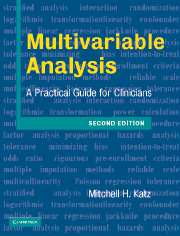Book contents
- Frontmatter
- Contents
- Preface
- 1 Introduction
- 2 Common uses of multivariable models
- 3 Outcome variables in multivariable analysis
- 4 Type of independent variables in multivariable analysis
- 5 Assumptions of multiple linear regression, multiple logistic regression, and proportional hazards analysis
- 6 Relationship of independent variables to one another
- 7 Setting up a multivariable analysis
- 8 Performing the analysis
- 9 Interpreting the analysis
- 10 Checking the assumptions of the analysis
- 11 Propensity scores
- 12 Correlated observations
- 13 Validation of models
- 14 Special topics
- 15 Publishing your study
- 16 Summary: Steps for constructing a multivariable model
- Index
5 - Assumptions of multiple linear regression, multiple logistic regression, and proportional hazards analysis
Published online by Cambridge University Press: 05 July 2011
- Frontmatter
- Contents
- Preface
- 1 Introduction
- 2 Common uses of multivariable models
- 3 Outcome variables in multivariable analysis
- 4 Type of independent variables in multivariable analysis
- 5 Assumptions of multiple linear regression, multiple logistic regression, and proportional hazards analysis
- 6 Relationship of independent variables to one another
- 7 Setting up a multivariable analysis
- 8 Performing the analysis
- 9 Interpreting the analysis
- 10 Checking the assumptions of the analysis
- 11 Propensity scores
- 12 Correlated observations
- 13 Validation of models
- 14 Special topics
- 15 Publishing your study
- 16 Summary: Steps for constructing a multivariable model
- Index
Summary
What are the assumptions of multiple linear regression, multiple logistic regression, and proportional hazards analysis?
As shown in Table 5.1, the assumptions underlying the three multivariable models differ somewhat with respect to what is being modeled, the relationship of multiple independent variables to outcome, the relationship of an interval-independent variable to the outcome, the distribution of the outcome variable, and the variance of the outcome variable. These assumptions are explained in this chapter.
Proportional hazards analysis has two additional assumptions with regard to censored observations and relative hazards over time (referred to as the proportionality assumption). These are dealt with in Sections 5.9 and 10.10, respectively.
What is being modeled in multiple linear regression, multiple logistic regression, and proportional hazards analysis?
In multiple linear regression, as the independent variable increases (or decreases) the mean or expected value of the outcome increases (or decreases) in a linear fashion. Many clinical situations fit this linear assumption.
For example, Figure 5.1 shows the relationship between B12 levels and pneumococcal antibody levels following receipt of pneumococcal vaccination among elderly persons. Each square represents an observation (a person) and their vitamin B12 level (the independent variable), and their antibody titer after vaccine (the dependent variable). Although arbitrary, the convention is to show the independent variable on the x-axis and the dependent variable on the y-axis.
Information
- Type
- Chapter
- Information
- Multivariable AnalysisA Practical Guide for Clinicians, pp. 38 - 67Publisher: Cambridge University PressPrint publication year: 2006
Accessibility standard: Unknown
Why this information is here
This section outlines the accessibility features of this content - including support for screen readers, full keyboard navigation and high-contrast display options. This may not be relevant for you.Accessibility Information
- 3
- Cited by
